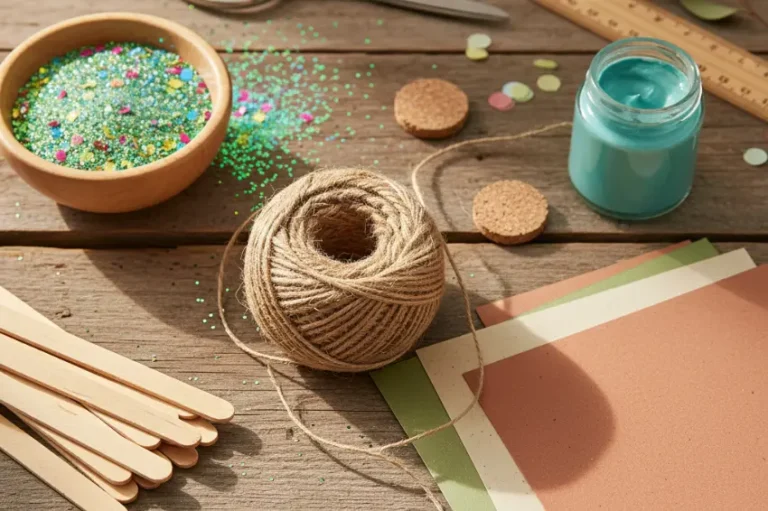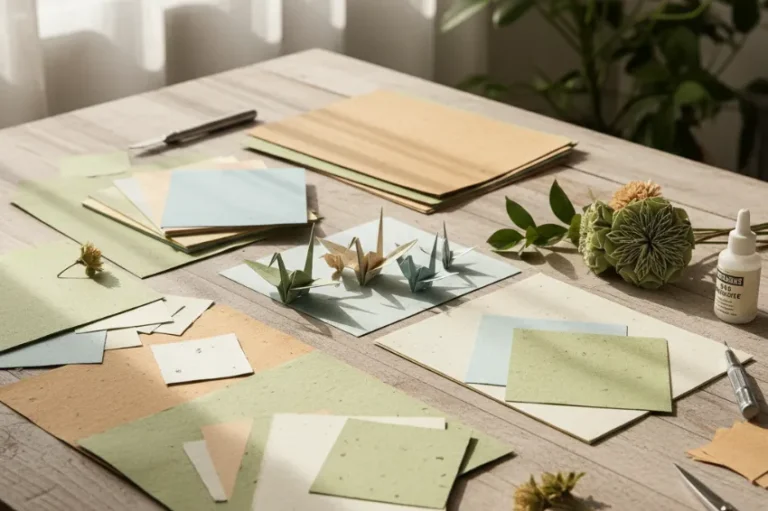40 Top Natural Materials Perfect for Eco-Friendly Crafts
Remember that feeling when you stumble upon a perfect seashell during a beach walk, and suddenly your mind floods with creative possibilities? That’s the magic of natural materials calling to the crafter in all of us. We’re living in a time when our creative choices carry weight beyond the craft room, and honestly, it feels good to know that your weekend project isn’t adding to landfill mountains.
The shift toward eco-friendly crafting isn’t just another trend that’ll fade like last season’s color palette. It’s a genuine movement toward creating with conscience, and trust me, working with natural materials opens up a world of textures, colors, and possibilities that synthetic alternatives simply can’t match. There’s something deeply satisfying about transforming what nature provides into something beautiful and functional with your own hands.
Whether you’re a seasoned crafter looking to green your creative practice or a curious beginner wondering where to start, natural materials offer an incredible playground. From fibers you can weave into textiles to found objects waiting to become art, these 40 materials prove that sustainability and stunning results aren’t mutually exclusive. Let’s dive into this collection and discover how going natural can actually expand your creative horizons rather than limit them.
Understanding Natural Materials in Crafting
Before we jump into our comprehensive list, let’s get clear on what makes a material truly “natural” and why it matters for your crafting journey.
Natural materials come directly from plants, animals, or minerals with minimal processing. We’re talking about resources that existed in nature before humans got involved, unlike synthetic materials created in laboratories. The beauty here is that these materials typically biodegrade at the end of their useful life, completing nature’s cycle rather than interrupting it.
Why natural materials deserve your attention:
You might wonder if switching to natural materials actually makes a difference. The answer is a resounding yes. Conventional craft supplies often contain plastics, chemical dyes, and synthetic adhesives that persist in the environment for centuries. Natural alternatives break down naturally, reducing your environmental footprint one project at a time.
But here’s the thing that really sealed the deal for me: working with natural materials connects you to the creative process in a way that mass-produced synthetics never will. Each piece of driftwood has its own character, every bundle of wool tells a story, and that imperfection? That’s not a flaw, that’s authenticity.
The practical benefits stack up quickly too. Many natural materials are surprisingly affordable, especially if you’re willing to forage responsibly or repurpose items you already have. They’re generally safer to work with, lacking the harsh chemicals and fumes that come with some synthetic options. And let’s be honest, there’s something inherently beautiful about materials that carry nature’s own color palette and texture.
Plant-Based Fibers and Fabrics
1. Organic Cotton
Starting with a classic that probably lives in your closet right now. Organic cotton skips the pesticides and harsh chemicals used in conventional cotton farming, making it gentler on the earth and your skin. Use it for sewing projects, quilting, or creating reusable shopping bags that actually look stylish.
The fabric takes natural dyes beautifully, and you’ll find it in weights ranging from lightweight muslin to sturdy canvas. One quick tip: pre-wash organic cotton before starting your project, as it tends to shrink slightly on that first wash.
2. Bamboo
Bamboo deserves its reputation as a superstar sustainable material. This fast-growing grass regenerates without replanting and requires minimal water compared to traditional timber. You’ll find bamboo in multiple forms for crafting: strips for weaving, sticks for structural projects, and even processed into soft fabric.
I love using bamboo sticks for creating garden markers, building miniature furniture, or assembling decorative structures. The natural nodes add visual interest, and the material is surprisingly strong despite its light weight.
3. Hemp Fiber
Hemp is having its moment, and for good reason. This incredibly durable plant-based fiber has been used for thousands of years, and it grows with minimal environmental impact. Hemp fabric gets softer with each wash while maintaining its strength, making it perfect for items that need to last.
Try hemp cord for macramé projects, hemp fabric for sturdy tote bags, or hemp paper for eco-conscious card making. The natural beige color provides a beautiful neutral base that complements almost any design aesthetic.
4. Jute
That rustic, textured fiber you see everywhere? That’s jute. This affordable natural fiber comes from the jute plant and brings instant warmth to any project. Jute twine is my go-to for wrapping gifts, creating plant hangers, or adding farmhouse-style details to home décor.
The material works wonderfully for coiled rope bowls, woven wall hangings, or even as a natural alternative to synthetic ribbon. Just remember that jute isn’t as water-resistant as some other fibers, so it’s best for indoor projects or items that won’t face the elements.
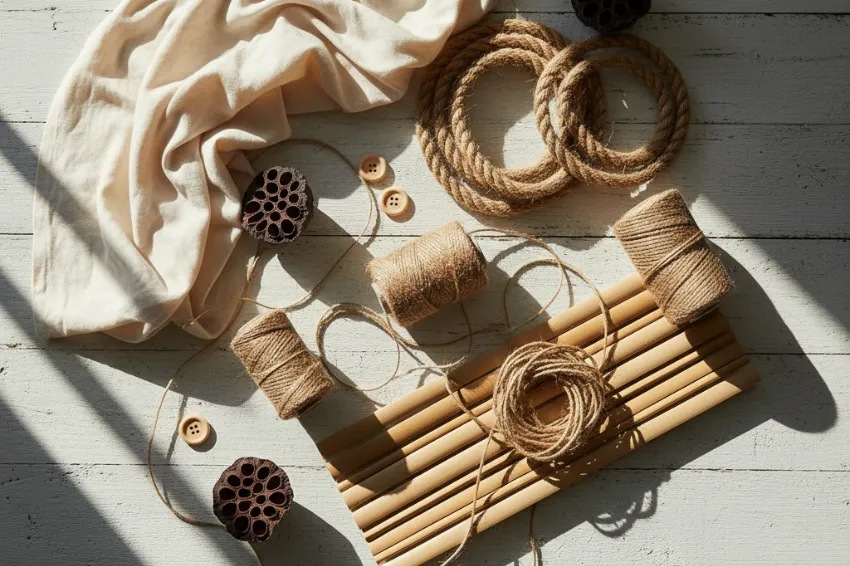
5. Linen
Linen brings elegance to eco-friendly crafting. Made from flax plants, this breathable fabric has a beautiful natural drape and develops a lovely worn-in character over time. Use unbleached linen for embroidery projects, table linens, or garment sewing.
The slightly irregular texture of linen adds character rather than looking like a flaw. It’s one of those materials that actually improves with age and use, developing a soft patina that synthetic fabrics can’t replicate.
6. Wool
Wool is renewable, biodegradable, and comes in more varieties than you might expect. From fine merino to rustic wool roving, this animal fiber offers incredible versatility for crafters. Wool felting has become hugely popular, allowing you to sculpt three-dimensional objects or create flat designs through needle felting techniques.
You can also use wool yarn for knitting, crocheting, or weaving projects. The natural crimp in wool fibers gives projects excellent stitch definition and warmth. Plus, wool naturally repels water and resists flames, making it practical beyond its eco-credentials.
7. Silk
When you want to add luxury to your sustainable crafting, silk answers the call. This protein fiber produced by silkworms has an unmistakable sheen and soft drape. Look for peace silk (also called Ahimsa silk) if you want to ensure the silkworms weren’t harmed in production.
Silk takes dyes exceptionally well, producing rich, vibrant colors. Use it for special occasion sewing projects, delicate scarves, or mixed-media art where you want a touch of elegance.
8. Sisal
This stiff, durable fiber comes from agave plants and works perfectly for projects needing structure. Sisal rope is excellent for creating sturdy baskets, scratch posts for cat furniture, or textured wall art. The natural golden color and coarse texture add character to rustic or coastal-themed projects.
Wood and Wood Products
9. Driftwood
Beach combers, this one’s for you. Driftwood pieces are pre-weathered by water and time, offering unique shapes and silvery-gray tones you can’t find anywhere else. Use smaller pieces for jewelry, medium branches for wall hangings, or larger logs as sculptural bases.
Each piece is genuinely one-of-a-kind, making your finished project inherently original. Just clean and dry your driftwood thoroughly before crafting to prevent mold or unwanted guests.
10. Birch Wood
Birch offers smooth, pale wood with distinctive dark markings that add natural beauty to projects. Birch slices and discs are perfect for creating rustic coasters, Christmas ornaments, or bases for centerpieces. The fine grain takes wood burning beautifully if you want to add personalized designs.
11. Bamboo Slices and Discs
Similar to wood slices but from fast-growing bamboo, these rounds provide the same rustic aesthetic with even better sustainability credentials. They’re lighter than traditional wood, making them ideal for hanging decorations or jewelry that won’t weigh you down.
12. Cork
Cork isn’t just for bulletin boards anymore. This renewable material is harvested from cork oak bark without harming the tree, which then regenerates its bark for future harvests. Cork sheets work beautifully for coasters, trivets, and craft backing. Cork’s natural texture and warm color coordinate with virtually any design style.
The material is naturally water-resistant and provides excellent insulation, making it practical for functional items. Cut it with sharp scissors or a craft knife, and you’re good to go.
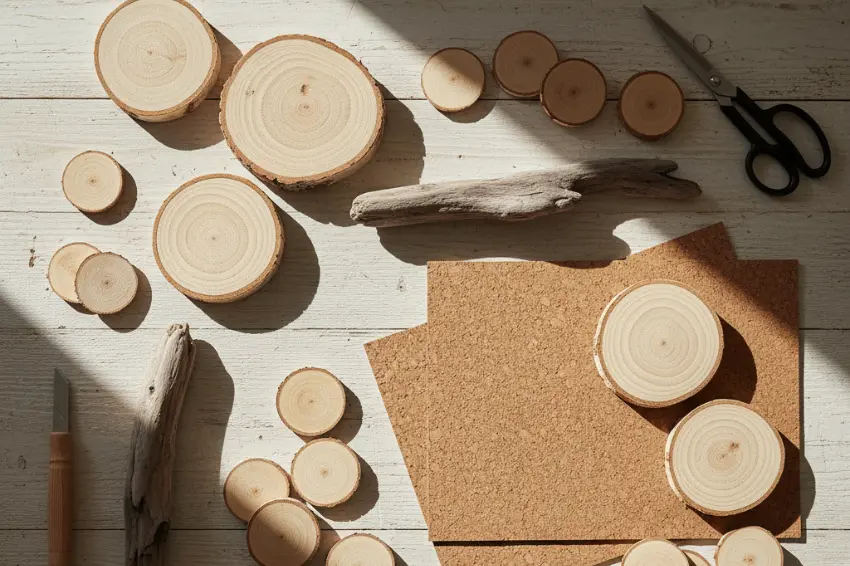
13. Reclaimed Wood
Old fence boards, pallet wood, or salvaged lumber get a second life in crafting. Reclaimed wood often has beautiful weathering, paint traces, or patina that new wood lacks. Use it for building shelves, creating wall art, or constructing rustic furniture pieces.
Always check reclaimed wood for nails, splinters, or rot before starting your project. A quick sanding can smooth rough edges while preserving that vintage character.
14. Pine Cones
These free natural treasures scattered under evergreen trees offer incredible crafting potential. Pine cones work for wreaths, garlands, fire starters, or even miniature Christmas trees. Their geometric structure and natural brown tones complement fall and winter décor especially well.
Clean pine cones by baking them at 200°F for about 30 minutes to kill any insects or bacteria. They’ll also open up fully during this process, making them easier to work with.
15. Wooden Buttons and Beads
These small wooden elements add natural charm to sewing and jewelry projects. Sustainably sourced wooden buttons bring warmth to garments, while wooden beads create earthy jewelry with minimal environmental impact.
Paper and Pulp Materials
16. Recycled Paper
Recycled kraft paper offers the perfect canvas for card making, gift wrapping, and paper crafts. The natural brown tone provides a rustic backdrop that looks intentional rather than plain. It accepts stamps, paint, and other embellishments beautifully.
You can even make your own recycled paper at home using scrap paper and a simple frame setup. It’s a bit messy but incredibly rewarding, and the results have gorgeous organic texture.
17. Handmade Plant Paper
Paper made with embedded flowers, leaves, or plant fibers takes recycled paper to the next level. These sheets often incorporate petals, grasses, or seeds directly into the pulp, creating stunning visual interest. Use them for special occasion cards, art journals, or framed botanical art.
18. Banana Paper
Paper made from banana plant fibers that would otherwise go to waste? Yes, please. This sustainable option typically comes from banana tree trunks after the fruit harvest. The resulting paper has a unique texture with visible fibers that add character to any project.
19. Mulberry Paper
Lightweight mulberry paper from Thailand and Japan offers delicate texture perfect for paper crafts, scrapbooking, and lampshade making. The long fibers create strong yet translucent sheets that glow beautifully when backlit.
Natural Dyes and Colorants
20. Plant-Based Dyes
Turmeric, indigo, madder root, and avocado pits can all create beautiful natural dyes for fabric and yarn. These vegetable and plant-based colorants produce softer, more complex colors than synthetic dyes, often with fascinating variations between batches.
The process takes more time than reaching for chemical dyes, but watching natural materials release their color into fabric feels like magic every single time. Plus, you’re avoiding the toxic chemicals that conventional dyes release into water systems.
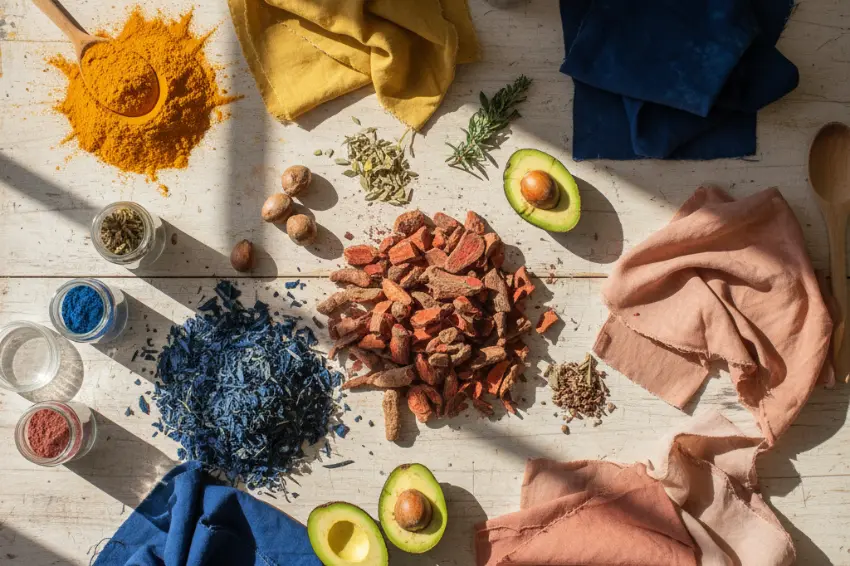
21. Cochineal and Lac Insects
These insect-based dyes produce stunning reds and pinks that have been prized for centuries. While they come from living creatures, small amounts produce intense color, making them more sustainable than many synthetic alternatives. They’re particularly popular with natural dyers seeking vibrant colors.
22. Walnut Hulls
Those green outer shells from black walnuts create rich brown dyes ranging from tan to deep chocolate. They’re easy to use and produce consistent results, making them perfect for beginners exploring natural dyeing.
Waxes and Natural Finishes
23. Beeswax
This versatile natural wax comes from honeybee hives and serves countless crafting purposes. Make eco-friendly candles, create beeswax wraps as an alternative to plastic wrap, or use it as a natural wood finish. Beeswax has a gentle honey scent and natural antibacterial properties.
It melts easily for pouring candles or coating fabrics, and hardens to a protective finish. Supporting beekeepers also helps protect these essential pollinators.
24. Carnauba Wax
Derived from Brazilian palm leaves, carnauba wax creates an especially hard, glossy finish. It’s perfect for high-shine wood finishes or adding durability to homemade natural furniture polish.
25. Soy Wax
For candle making, soy wax offers a renewable alternative to petroleum-based paraffin. It burns cleaner and longer, holds fragrance well, and cleans up easily with soap and water. Most soy wax comes in flake form that melts smoothly for consistent candle making.
Clay and Earth Materials
26. Air-Dry Clay
Natural clay that hardens without kiln firing makes sculpture and modeling accessible to everyone. These clays are typically non-toxic and biodegradable, perfect for creating ornaments, beads, or small sculptures. The earthy material has a pleasant smell and smooth texture that’s genuinely enjoyable to work with.
27. Pottery Clay
Traditional pottery clay requires firing but creates durable, functional pieces. If you have access to a kiln, natural stoneware or earthenware clay lets you create dishes, planters, or decorative objects that last for years.
28. Salt Dough
Made from flour, salt, and water, this craft staple costs pennies and works beautifully for ornaments and decorations. It air-dries hard and can be painted with natural or conventional paints. Kids love working with salt dough, making it perfect for family craft sessions.
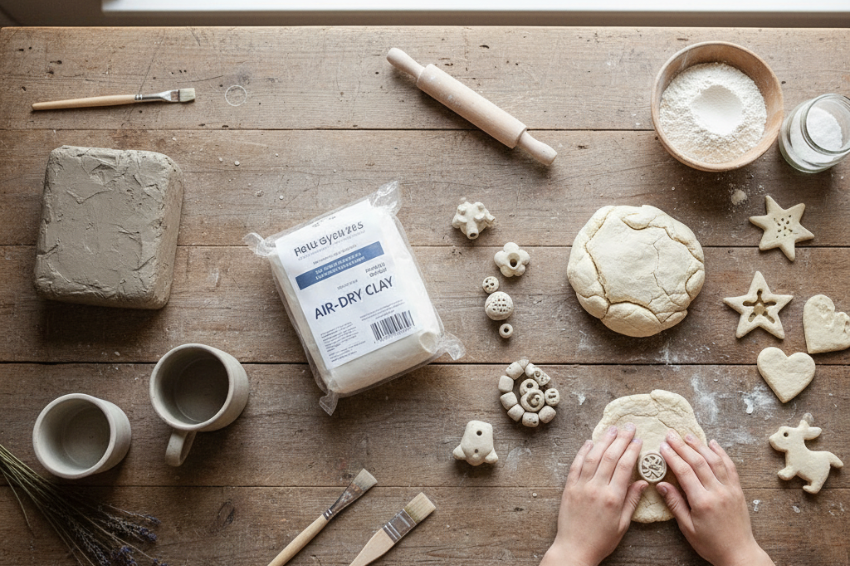
Stone and Mineral Materials
29. River Rocks and Pebbles
Smooth stones from rivers and beaches serve as natural canvases for painting, bases for wire-wrapped jewelry, or elements in zen gardens. Their natural shapes and colors require no processing, just cleaning and drying.
Rock painting has exploded in popularity, with communities hiding painted stones for others to find. It’s crafting that spreads joy beyond your own home.
30. Sea Glass
Weathered glass smoothed by ocean waves creates jewelry and mosaics with built-in history. Each piece started as a bottle or container, making sea glass the ultimate upcycled material. The frosted surface and soft edges give projects a beachy, bohemian vibe.
31. Natural Crystals
Quartz, amethyst, and other natural crystals add sparkle to jewelry and decorative projects. While mining does have environmental impact, choosing ethically sourced crystals helps minimize harm while bringing earth’s natural beauty into your work.
Botanical Materials
32. Dried Flowers
Preserving garden blooms extends their beauty indefinitely. Dried flowers work wonderfully in wreaths, shadow boxes, resin jewelry, or pressed flower art. Roses, lavender, and statice hold their color especially well during drying.
Hang flowers upside down in a dark, dry space for the best preservation results. You’ll maintain more color than leaving them in bright light.
33. Leaves and Foliage
Pressed leaves create beautiful botanical art, and preserved foliage adds natural elements to wreaths and arrangements. Glycerin preservation keeps leaves supple, while pressing flattens them for framing or card making.
Fall leaves in particular offer spectacular color variations that make every piece unique. Just remember to press them between paper towels and heavy books for a week or two before using them in projects.
34. Seed Pods
Interesting seed pods from plants like poppy, lotus, or eucalyptus add sculptural interest to arrangements and nature crafts. Their unique shapes and textures create visual focal points that manufactured materials can’t replicate.
35. Twigs and Branches
Small branches form the structure for natural wreaths, create rustic picture frames, or build miniature fairy houses. Willow branches are especially popular because they’re flexible when fresh, allowing you to weave them into shapes that harden as they dry.
36. Acorns and Nuts
These autumn treasures work for nature table displays, garland making, or painting projects. Acorn caps are particularly charming for creating miniature containers or fairy tea cups.
37. Moss
Preserved or dried moss adds lush green texture to terrariums, wreaths, and fairy gardens. Spanish moss drapes beautifully, while sheet moss creates carpet-like surfaces. You can even grow live moss for truly sustainable projects that continue thriving after completion.
Grasses and Reeds
38. Seagrass
This coastal plant material is incredibly durable and perfect for basket weaving, rope making, or creating rustic home décor. Seagrass naturally resists moisture better than many materials, making it practical for kitchen or bathroom items.
The natural variations in color create striped effects in woven pieces without any dyeing needed.
39. Water Hyacinth
Despite being an invasive species in many areas, water hyacinth creates beautiful woven items. Using this material for crafting actually helps remove it from waterways where it causes problems. The hollow stems create lightweight yet strong baskets, mats, and furniture pieces.
40. Raffia
This natural fiber from raffia palm leaves works beautifully for weaving, gift wrapping, or adding decorative touches to packages. It’s softer and more pliable than jute but still provides that natural aesthetic. Raffia comes in natural tan and dyed colors, offering versatility for different design visions.
Comparison Table: Natural Materials by Project Type
| Material Type | Best For | Skill Level | Durability | Cost |
|---|---|---|---|---|
| Organic Cotton | Sewing, quilting, bags | Beginner-Advanced | High | Moderate |
| Bamboo | Structures, weaving | Beginner-Intermediate | High | Low-Moderate |
| Wool | Felting, knitting, weaving | Intermediate-Advanced | High | Moderate-High |
| Cork | Coasters, backing, stamps | Beginner | High | Low-Moderate |
| Beeswax | Candles, wraps, finishes | Beginner-Intermediate | Moderate | Moderate |
| Air-Dry Clay | Sculpture, ornaments | Beginner | Moderate | Low |
| Dried Flowers | Wreaths, resin art, cards | Beginner | Low-Moderate | Free-Low |
| Jute | Macramé, wrapping, weaving | Beginner-Intermediate | Moderate | Low |
| Driftwood | Wall art, sculpture | Intermediate | High | Free |
| Natural Dyes | Fabric/yarn coloring | Intermediate-Advanced | High (on fabric) | Low-Moderate |
Tips for Sourcing Natural Materials Responsibly
Finding natural materials doesn’t mean stripping your local forest bare. Here’s how to gather responsibly:
Forage with permission and awareness. Only collect from public lands where it’s allowed, or ask landowners before taking anything from private property. Never harvest from protected areas or remove so much that you damage the ecosystem.
Leave more than you take. The general rule is to harvest no more than 10% of what you see. If there are only a few pine cones under that tree, leave them for wildlife and seed dispersal.
Buy certified sustainable products. Look for certifications like GOTS (Global Organic Textile Standard) for fabrics, FSC (Forest Stewardship Council) for wood products, or Fair Trade labels that ensure ethical production.
Support local artisans and suppliers. Buying from local sources reduces shipping impact and often guarantees fresher, higher-quality materials. Plus, you’re supporting your community’s creative economy.
Consider the full lifecycle. Even natural materials have environmental impact during harvesting and transport. Choose materials produced close to home when possible, and think about whether you’ll actually use them before purchasing.
Getting Started with Natural Materials
Feeling overwhelmed by all these options? Start simple. Pick one or two materials that appeal to you and experiment with small projects first. You don’t need to master everything at once.
Begin with what you know. If you already sew, start with organic cotton or linen. If you love painting, try natural dyes or watercolors on recycled paper. Building on existing skills makes the transition to natural materials less intimidating.
Start a materials collection. Keep a box or basket for interesting natural finds during walks—smooth stones, interesting twigs, pine cones, or seed pods. You’ll build a free stash of materials while staying tuned into nature’s offerings.
Join crafting communities. Online groups dedicated to eco-friendly crafting offer inspiration, troubleshooting help, and moral support. You’ll discover techniques you never imagined and connect with others who share your values.
Embrace imperfection. Natural materials come with variations that synthetic products lack. That’s not a bug, it’s a feature. The unique characteristics of each material make your projects genuinely one-of-a-kind.
Caring for Natural Material Projects
Once you’ve created something beautiful, you’ll want it to last. Natural materials require slightly different care than synthetic alternatives:
Keep most natural fiber textiles away from direct sunlight, which can fade colors and weaken fibers over time. Store wool items with cedar or lavender to prevent moth damage naturally, without chemical mothballs.
Wood projects benefit from occasional oiling with natural oils like linseed or tung oil to prevent drying and cracking. Avoid soaking wooden items in water, which can cause warping or splitting.
Natural dyes may fade faster than synthetic ones, but that gentle aging is part of their charm. Some crafters intentionally embrace the faded look as a patina that shows the piece’s history.
Projects made with botanical materials like dried flowers will eventually fade and become brittle. Consider them beautiful but temporary, or preserve them behind glass to extend their lifespan.
The Bigger Picture: Why Your Materials Matter
Every time you choose natural materials over synthetic alternatives, you’re casting a vote for the kind of world you want to live in. That might sound dramatic for a craft supply decision, but small choices compound into significant impact.
The craft industry churns out tons of plastic-based supplies annually, much of which ends up in landfills or oceans. Natural materials break down naturally, completing their lifecycle without leaving permanent pollution behind.
Beyond environmental impact, there’s something deeply satisfying about creating with materials that connect you to the natural world. In our increasingly digital lives, working with tangible, earth-derived materials grounds us and reminds us of our place in nature’s systems.
You’re also supporting agricultural systems that work with nature rather than against it. Organic cotton farming improves soil health. Sustainable forestry maintains forest ecosystems. Hemp cultivation requires minimal inputs while improving soil for future crops. Your material choices support these regenerative practices.
Conclusion
We’ve journeyed through 40 natural materials that prove sustainable crafting isn’t about limitation—it’s about possibility. From soft organic cotton to sturdy bamboo, fragrant beeswax to earthy clay, these materials offer textures, colors, and creative potential that synthetic alternatives simply can’t match.
Starting your natural materials journey doesn’t require a complete overhaul of your craft room. Begin with one material that speaks to you. Try organic cotton for your next sewing project. Experiment with plant-based dyes. Collect pine cones during your next nature walk. Each small step builds momentum toward a more sustainable creative practice.
The beauty is that natural materials often cost less than their synthetic counterparts, especially when you forage responsibly or repurpose what others discard. You’re not sacrificing quality or aesthetics—you’re actually elevating both while reducing your environmental footprint.
Your creations have stories now. That basket woven from water hyacinth removed invasive plants from waterways. Those candles made from beeswax support pollinators. The quilted bag crafted from organic cotton avoided pesticides that harm farmworkers and ecosystems. Every project becomes meaningful beyond its practical use.
So grab some natural materials and start creating. The planet will thank you, and your future self will love the unique, beautiful pieces you’ve made with your own hands. What will you craft first?
Frequently Asked Questions
How do I prevent mold when using natural materials like wood or botanical elements?
The key to mold prevention is ensuring materials are completely dry before crafting and storing finished projects in low-humidity environments. For wood pieces, apply natural finishes like beeswax or linseed oil that seal the surface without trapping moisture. With botanical materials like dried flowers or leaves, make sure they’re thoroughly dried (this can take 1-2 weeks) before incorporating them into projects.
If you live in a humid climate, consider adding silica gel packets to storage containers with natural material projects, or use a dehumidifier in your craft space. For items that will live outdoors, choose naturally rot-resistant materials like cedar or redwood.
Can natural dyes create bright, vibrant colors or are they always muted?
Natural dyes can definitely achieve vibrant colors, though they often present a different color palette than synthetic dyes. Cochineal insects produce brilliant reds and pinks, indigo creates stunning blues, and madder root yields vivid oranges and reds. The key is using mordants (mineral fixatives like alum or iron) that help colors bind to fibers and intensify hues. Fresh dye materials typically produce brighter results than old ones. That said, part of natural dyeing’s charm is embracing slightly more complex, nuanced colors rather than the flat, electric brightness of synthetic dyes. The subtle variations between batches become a feature rather than a flaw.
What’s the shelf life of natural crafting materials, and how should I store them?
Storage needs vary significantly by material type. Plant-based fibers like cotton, hemp, and linen can last decades when stored in cool, dry places away from direct sunlight, ideally in breathable cotton bags rather than plastic. Wool should be stored with natural moth deterrents like cedar or lavender. Clay and salt dough need airtight containers to prevent drying out before use. Beeswax and other natural waxes last indefinitely when kept cool and dry. Dried botanical materials will fade over time but remain usable for years if kept away from moisture and direct light. Natural dye materials in powder form stay potent for several years in sealed containers, while fresh materials should be used quickly or frozen for later use.
Are there any natural materials I should avoid if I have pets or small children?
Safety always comes first with little ones and furry friends around. Avoid small items like beads, buttons, or acorns that present choking hazards for children under three.
Some natural materials can be toxic if ingested—eucalyptus, yew, and oleander are examples of plants whose parts shouldn’t be used in homes with curious toddlers or pets who chew.
Clay should be non-toxic and specifically labeled as child-safe. Walnut hulls and shells can be toxic to dogs specifically. Essential oils used in natural projects can also be harmful to cats. When in doubt, research any plant-based material before bringing it into your home, and always supervise young children during craft time. Stick with larger items and confirmed non-toxic materials for the safest crafting experience.
How do natural materials hold up in outdoor projects compared to weather-resistant synthetics?
Natural materials can definitely work for outdoor projects, but you need to choose wisely and maintain them properly. Cedar, redwood, and teak contain natural oils that resist rot and insects, making them excellent for outdoor furniture or garden structures. Properly sealed bamboo also weathers well. Stone and heavy branches handle weather beautifully without any treatment. However, most natural fabrics and untreated wood will degrade faster outdoors than synthetic alternatives—that’s simply the trade-off for biodegradability.
You can extend outdoor life by applying natural water-resistant finishes like linseed oil or beeswax, bringing projects under cover during harsh weather, or embracing the weathered aesthetic as materials naturally patina over time. For projects that must withstand constant outdoor exposure, sometimes a carefully chosen synthetic material is the more sustainable choice if it means the project lasts decades rather than years.
Recommended Natural Crafting Products
To help you get started with eco-friendly crafting, here are some high-quality natural materials worth considering:
| Product Name | Description |
|---|---|
| Organic Cotton Fabric | Soft, pesticide-free cotton fabric ideal for sewing and textile eco crafts |
| Bamboo Craft Sticks | Durable bamboo sticks perfect for building natural craft structures and decorations |
| Jute Twine | Natural jute twine for wrapping, macramé, and rustic crafting |
| Recycled Kraft Paper Sheets | Eco-friendly recycled paper for card making and paper crafts |
| Plant-Based Natural Dyes | Vegetable and flower-based dye powders for coloring fabric and paper naturally |
| Wool Roving for Felting | Soft wool roving suitable for needle felting and sustainable wool crafts |
| Coconut Shell Craft Blanks | Natural coconut shells ready for carving or decoration projects |
| Unbleached Linen Fabric | Linen fabric with minimal processing, perfect for eco-conscious textile projects |
| Natural Beeswax | Organic beeswax for making eco-friendly candles and craft finishes |
| Seagrass Rope | Durable seagrass rope for rustic and natural craft projects |
| Water Hyacinth Basket Kit | DIY kit using natural water hyacinth for weaving baskets and storage items |
| Organic Hemp Fiber Rolls | Strong hemp fiber for weaving and eco-textile crafts |
| Natural Clay Air-Dry Modeling Kit | Non-toxic, biodegradable clay for natural modeling and sculpting |
| Wooden Buttons | Sustainably sourced wooden buttons for natural textile embellishments |
| Natural Cork Sheets | Eco-friendly cork sheets for craft backing, coasters, and decorations |
| Birch Wood Craft Discs | Smooth wooden discs from birch, perfect for engraving and eco crafts |
| Organic Silk Yarn | Luxurious silk yarn from sustainable sources for natural textile crafts |
| Pinecones and Acorns Pack | Collection of natural forest materials for nature-inspired crafts |
| Recycled Glass Beads | Beautiful beads made from recycled glass, ideal for eco jewelry and decoration |
| Eco-Friendly Natural Paint Set | Water-based, plant-derived paints for sustainable crafting with minimal environmental impact |
Each of these products offers a starting point for incorporating natural materials into your creative practice. Remember that the best material for any project is the one that matches your skill level, budget, and creative vision while aligning with your sustainability values.

